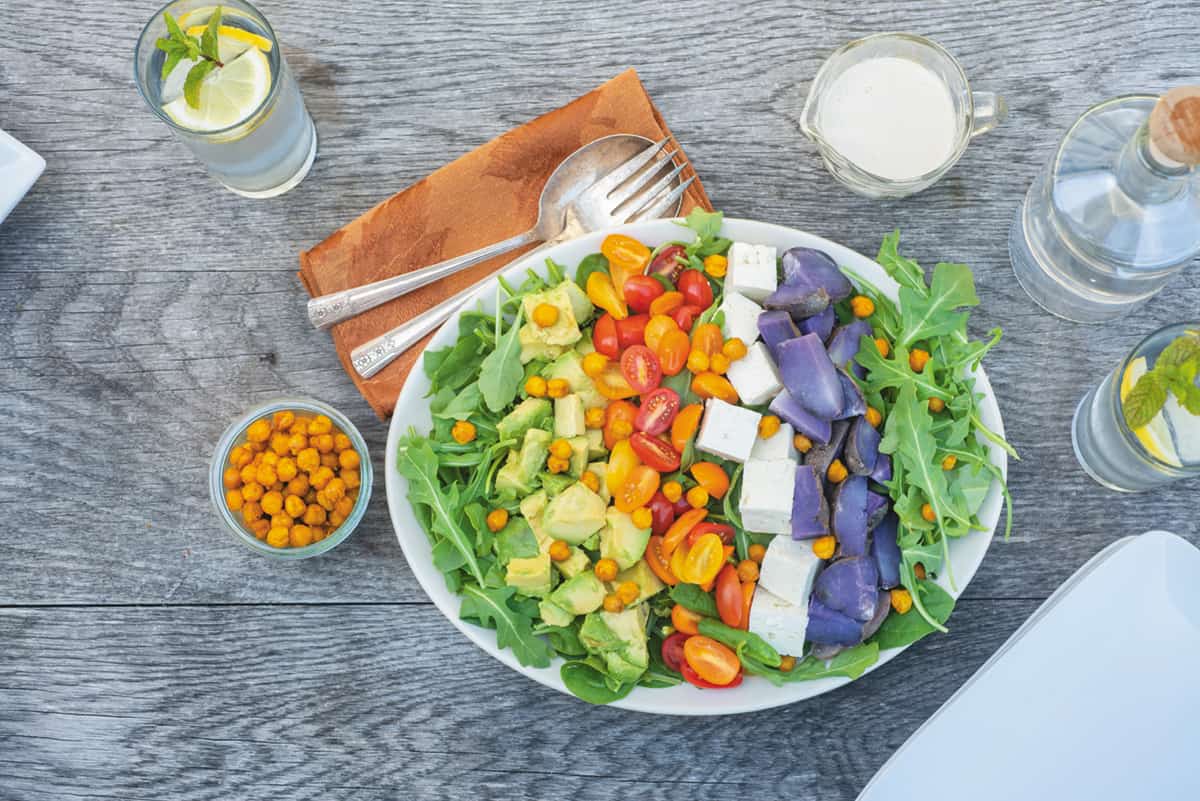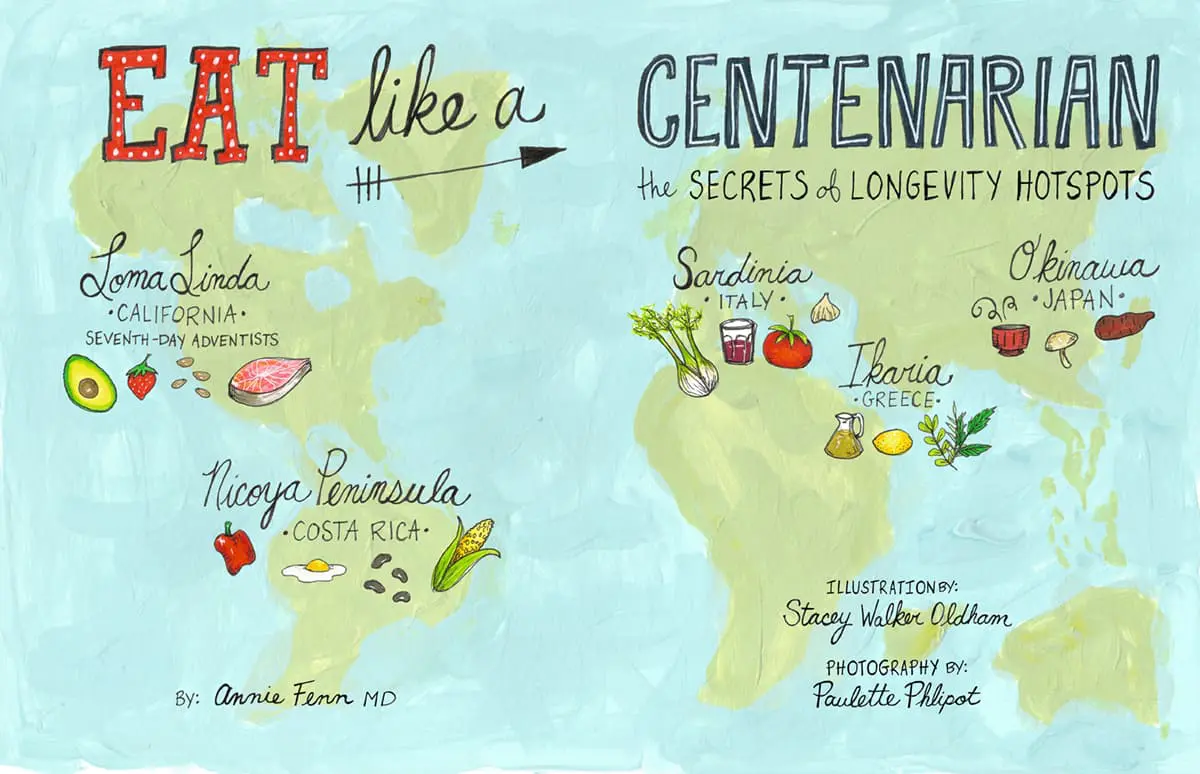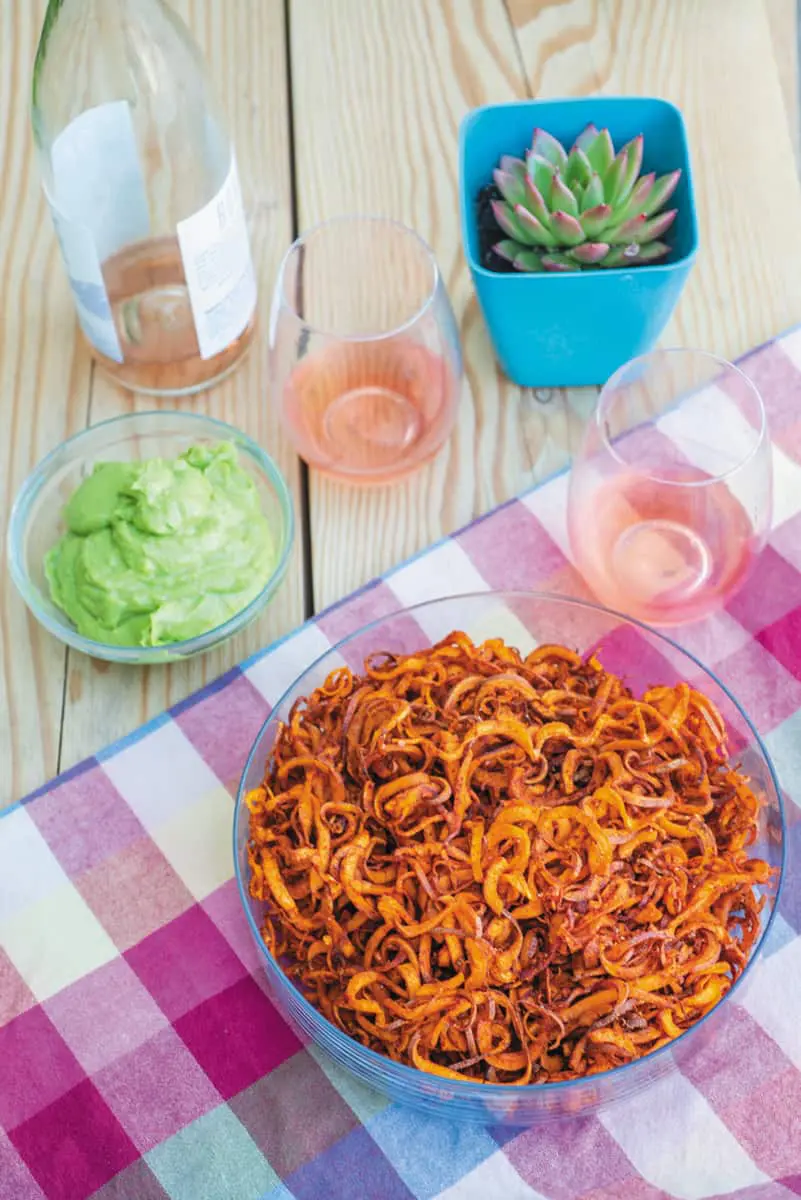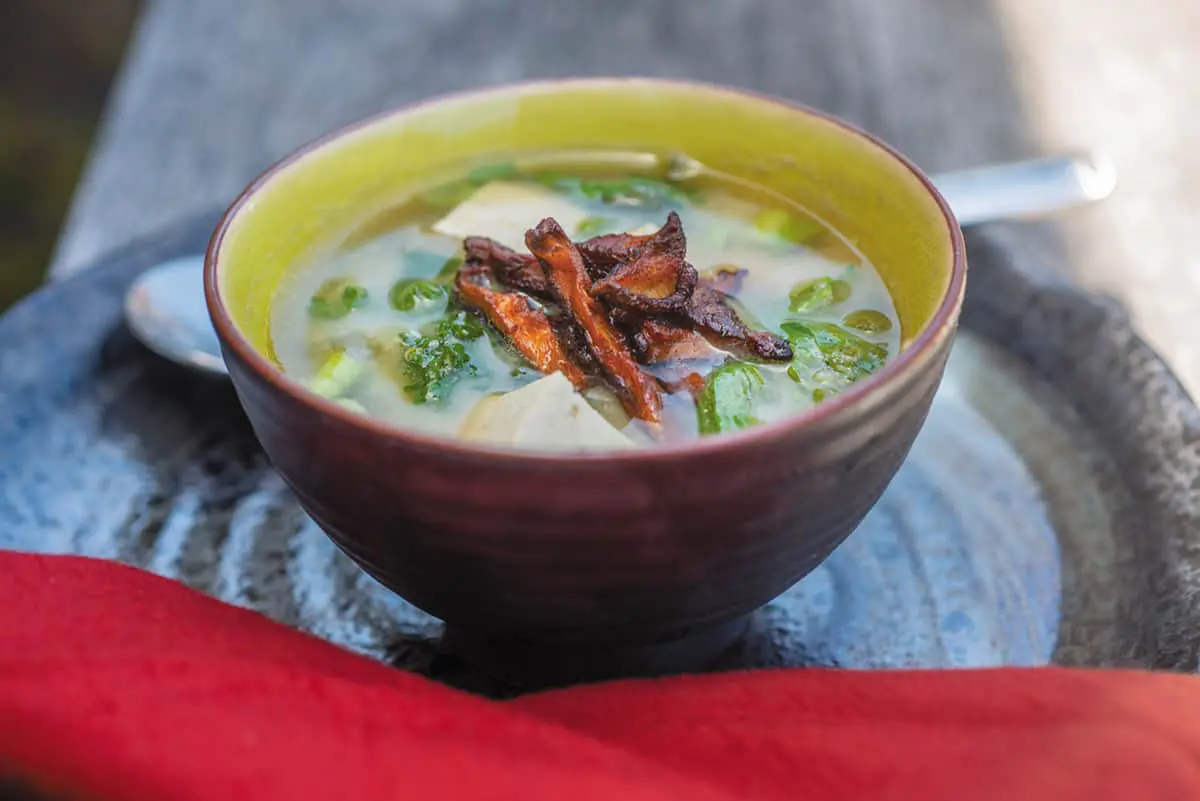By Annie Fenn M.D. // Illustration by Stacey Walker Oldham + Photography by Paulette Phlipot
—
Move over millennials. The centenarian is on the rise.
As our population matures, people who reach their hundredth birthday are now the fastest growing age group in the United States. In fact, according to data from the Census Bureau, the younger you are now, the longer you are likely to live. A baby born today has a one-in-three chance in reaching 100 years old. And if you’ve already reached the ripe age of 55, your chance of achieving centenarian status is one in ten.
But of course, it’s not just how long we live, it’s also how well we live. Studying healthy centenarians gives us clues to thrive—not just survive—into our last decades.
Blue Zones
National Geographic fellow, journalist, and producer Dan Buettner first coined the term “Blue Zones” ten years ago when he set out to study longevity hotspots around the globe. He was searching for answers to the question: How does one live a healthier, more fulfilling, and longer life? What he found had more to do with lifestyle than genes. Healthy, dementia-free centenarians shared common habits, whether they lived in Costa Rica or Japan. They had a similar way of eating, moving, socializing, and finding purpose in life.
The link between Blue Zoners’ habits and longevity jives with the latest science, too. Lifestyle factors have been proven to alter the genes that keep us healthy and turn off genes that promote chronic disease. Diet and lifestyle may even begin to reverse aging at the cellular level by lengthening telomeres (the part of the chromosome that affects how our cells age). As your telomeres become longer, so does your life. And the more people adopt healthy lifestyle habits—like those of the Blue Zoners—the longer their telomeres become.
Blue Zoning Your Social Life
Take Blue Zoners’ social habits, for instance. They socialize a lot—as much as five hours each day. In Okinawa, Japan, they create moais, groups of friends that commit to each other for life. On the island of Sardinia, Italy, home to the longest-living men on Earth, the locals are famous for gathering at the end of each day to laugh and trade stories over wine. Research shows that the people we choose to spend time with reinforce our daily habits. In other words, hang out with smokers and you are more likely to smoke. Surround yourself with lonely people and you become lonely, too. Negative habits are contagious, but so are the positive ones. Choosing the right tribe can not only make you happier, but can also help you live longer.
Practicing Moderation
Eating like a Blue Zoner starts with gratitude. Okinawans pause before each meal to say “hara hachi bu,” a 2,500-year-old Confucian phrase that reminds them to stop eating when their stomach is 80% full. Building portion control into their culture helps the Japanese maintain a healthy weight throughout their lives. In fact, all longevity diets everywhere contain fewer calories than we are used to eating—about 20% less than the average American.
Another healthy eating habit involves not eating at all. Intermittent fasting, the hottest new diet trend, is something healthy centenarians have been practicing forever. Recent studies show that occasionally going without food, even for a day, provides health benefits. Fasting can recalibrate insulin release, giving your pancreas a break. And when the body is no longer busy metabolizing the byproducts of what we eat, it cleans up free radicals that can damage blood vessels and brain cells. Most Blue Zoners fast as part of a religious ritual (Lent, for instance), but anyone can fast intermittently to reap the same benefits.
Blue Zoning Your Pantry
Buettner identified forty-four foods enjoyed by Blue Zone centenarians, and all are nutrient-dense whole foods. But it’s not just the nutritional value of the ingredients that keeps these folks young as they age. They also pay attention to where their food is grown, how it’s prepared, and the rituals that surround it. They value when it’s consumed and with whom.
And while some Blue Zone foods may be unfamiliar—like pejvalles, a palm fruit enjoyed in Costa Rica, or the “bitter melon” of Okinawa—most are found at your local grocery store and are downright delicious and easy to prepare.
Here are some examples of foods and culinary customs from a few of the Blue Zones that Buettner identified around the world…
Sardinia, Italy
Sardinians enjoy bread, beans, vegetables, local cheeses, and wine. Grains comprise 47% of their calories, and no more than 5% comes from meat, fish, and poultry.
Dietary staples
- Fennel, chickpeas, tomatoes, fava beans, and almonds.
- Cheese, made locally from sheep and goat milk.
- Barley, risotto, and locally made, fermented sourdough bread.
- Cannonau wine made from sun-stressed Grenache grapes. This Sardinian wine has three times the potent antioxidant resveratrol than other red wines.
Seventh-Day Adventists, Loma Linda, California
A study of 34,000 Adventists over fourteen years showed a lifespan of ten years longer than the average American. With a diet best described as pescatarian (no meat, just fish), they eat most of their calories during the day, and enjoy their biggest meal in the late afternoon.
Dietary staples
- Oatmeal, berries, plant-based milks, avocado, and beans.
- Adventists favor salmon; they don’t eat fish without scales or fins.
- This group enjoys a handful of nuts at least five times each week.
- As the only alcohol-free Blue Zoners, Adventists teach us that you don’t need to consume wine to live a long time.
Ikaria, Greece
Ikarians enjoy a diet rich in greens, vegetables, and beans, which make up most of their calories. Fat accounts for more than 50% of their calories, more than half of that from olive oil. They eat small amounts of fish and local meats.
Dietary staples
- Coffee, raw local honey, feta cheese, black-eyed peas, chickpeas, and Mediterranean herbs (rosemary, marjoram, oregano, mint).
- Ikarians seek out wild greens (Asian or mustard greens). They forage watercress, nettle, and dandelion greens.
- Whole lemons—juice, pulp, and rind—are used to season foods.
- Extra virgin olive is a pantry staple.
Okinawa, Japan
On an island with the most centenarians per capita in the world, Okinawans eat an abundance of vegetables and sip on miso soup for breakfast. Their staple vegetable, satsuma imo, is a purple yam packed with slow-burning carbs. Purple fingerling potatoes also contain the same potent antioxidants.
Dietary staples
- Tofu, miso paste, purple potatoes, brown rice, and mushrooms.
- Okinawans choose garlic and both fresh and dried turmeric.
- Seaweed is eaten alongside most dishes (kombu, wakame, and hijiki).
- Green tea.
Nicoya Peninsula, Costa Rica
Nicoyans eat a lot of carbs, consisting of up to 80% of their calories. They favor handmade corn tortillas made from corn soaked in lime and ground into a flour.
Dietary staples
- Corn tortillas, black beans, sweet potatoes, squash, bananas, and papaya.
- Nicoyans season foods with local peppers, onions, and garlic.
- Meals are often topped with a pastured, farm-fresh egg.
Armed with this longevity shopping list and a few recipes to get you started, you can create a Blue Zone wherever you live.
Cobb Salad with Crispy Chickpeas
—
Serves 2 as a meal or 4 as a side
—
The quintessentially American Cobb salad gets a Blue Zone makeover with a few strategic swaps: dark leafy greens, crispy chickpeas, and feta instead of blue cheese.
—
For the Crispy Chickpeas:
1 can (15-ounce) chickpeas or 2 cups fresh cooked chickpeas, drained and patted dry
2 teaspoons extra virgin olive oil
½ teaspoon turmeric
½ teaspoon sea salt, fine
- Preheat the oven to 350ºF.
- Place the drained, patted-dry chickpeas in a medium bowl. Add the olive oil, turmeric, and salt, and stir to thoroughly coat.
- Transfer chickpeas to a rimmed baking sheet lined with parchment paper; spread in a single layer.
- Bake 30 minutes, or until golden and crispy. Give the pan a shake halfway through so the chickpeas will crisp up evenly. Watch carefully so they don’t burn.
- When done, cool them on the pan. Set aside until you finish the salad.
Note: Leftover chickpeas will become soft. Refresh in a 350ºF oven until crisp.
For the Lemony Tahini Dressing:
¼ cup tahini
1 ½ teaspoons fresh lemon juice
1 small clove garlic, minced
2 tablespoons pure maple syrup
¼ cup water
- Place all the ingredients in the bowl of a food processor or blender.
- Puree until smooth and pourable, adding more water if needed.
For the Salad:
6 cups mixed greens (watercress, arugula, or other dark leafy green)
1 cup grape or cherry tomatoes, halved
2 ripe avocados, cut into 1-inch cubes
1 cup feta cheese, cut into 1-inch cubes
2 cups purple fingerling potatoes, boiled until tender and cut into 1-inch pieces
coarse sea salt, for finishing
- Place the greens on a large plate or shallow bowl.
- Assemble with avocado, tomatoes, feta cheese, and purple potatoes, giving each ingredient its own self-contained lane.
- Sprinkle liberally with sea salt, crispy chickpeas, and a drizzle of dressing.
Sweet Potato Fries with Avocado Mayo
—
Serves 4 as an appetizer
—
For the Fries:
2 sweet potatoes, scrubbed and dried
3 tablespoons olive oil
2 tablespoons paprika
2 teaspoons coarse sea salt
- Preheat oven to 400ºF. Place a rimmed baking sheet in the oven to preheat.
- Spiralize the sweet potatoes with a spiralizer. Place in a large bowl and toss with olive oil, paprika, and salt.
- Place the spiralized sweet potatoes on the hot baking sheet, spread out in a single layer.
- Bake 20 to 30 minutes until crisp and brown on the edges. (Watch carefully so they don’t burn.)
Tips and Tricks: There are two tricks to making crisp sweet potato fries in the oven: 1. Preheat the baking sheet before adding the fries, and 2. Use a spiralizer to cut them.
For the Avocado Mayo:
1 ripe avocado
zest of 1 lime
3 tablespoons fresh squeezed lime juice
1 teaspoon ginger root, grated
½ small garlic clove, crushed
dash Tabasco or Sriracha (optional)
1 tablespoon olive oil
1 tablespoon cold water
large pinch fine sea salt
- Place the avocado flesh in a food processor. Zest the lime. Add in all the ingredients in order, including Tabasco, if using.
- Whizz until smooth. Transfer to a dish or cover with plastic wrap that touches the sauce to seal out the air (to prevent discoloring).
- When the fries are done, serve them immediately alongside the avocado mayo for dipping.
Green Tea Miso Soup with Mustard Greens and Shiitake Bacon
—
Serves 4
—
For the Shiitake bacon:
4 cups shiitake mushrooms
2 teaspoons liquid smoke
4 teaspoons low-sodium soy sauce
1 teaspoon smoked paprika
2 teaspoons maple syrup
2 teaspoons Worcestershire sauce
2 tablespoons olive oil
½ teaspoon coarse sea salt
freshly ground pepper, to taste
- Preheat the oven to 350ºF. Line a rimmed baking sheet with parchment paper or a silicone mat.
- Destem the shiitake mushrooms and slice them into 1/2-inch slices
- In a large bowl, whisk together all the other ingredients.
- Add the mushrooms to the bowl and toss gently until evenly coated. Marinate for 15 minutes.
- Pour the mushrooms onto the baking sheet and separate them so they aren’t touching.
- Bake for 30 minutes, flipping after 15, until crispy.
Note: You can substitute 4 Portobello mushrooms for the shiitakes. Bake for 45-50 minutes, or until crispy.
For the Soup:
1 ½ cups water
2 green tea bags
1 teaspoon sesame oil
1 teaspoon minced ginger
1 ½ cups vegetable or chicken broth
½ cup firm tofu, cut into 1/2- inch cubes
¹⁄3 cup miso paste
2 cups mustard greens
1 teaspoon soy sauce
¹⁄3 cup chopped scallions
- Boil the water in a medium saucepan. Remove from heat and add the green tea bags. Steep for 3 to 4 minutes. Remove the tea bags, pour the tea into a measuring cup and set aside.
- Using the same saucepan over medium heat, add the sesame oil and ginger. Sauté for 30 seconds. Then, add the broth, tofu, and green tea. Bring to a boil, then reduce the heat to a gentle simmer.
- Place the miso paste in a small bowl and add a ladleful of the hot broth. Whisk with a fork until smooth and add back into the soup.
- Add the greens, soy sauce, and scallions. Simmer gently (don’t boil) until the greens are al dente, about 3 to 4 minutes.
- Ladle soup into bowls and top with shiitake bacon.




